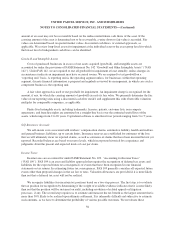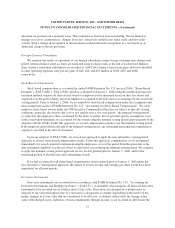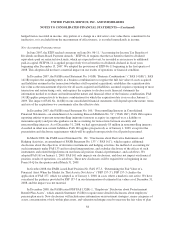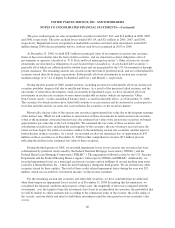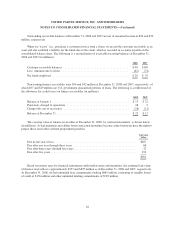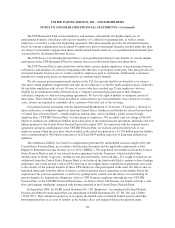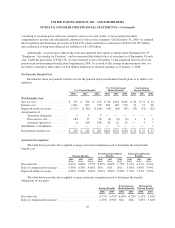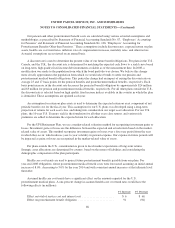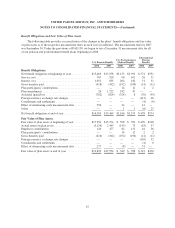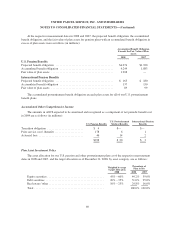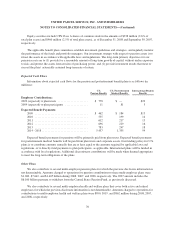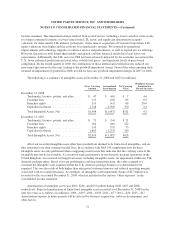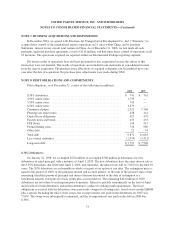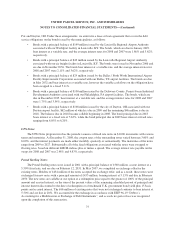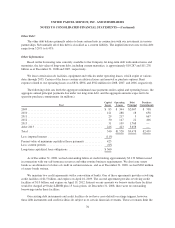UPS 2008 Annual Report Download - page 77
Download and view the complete annual report
Please find page 77 of the 2008 UPS annual report below. You can navigate through the pages in the report by either clicking on the pages listed below, or by using the keyword search tool below to find specific information within the annual report.
UNITED PARCEL SERVICE, INC. AND SUBSIDIARIES
NOTES TO CONSOLIDATED FINANCIAL STATEMENTS—(Continued)
Our pension and other postretirement benefit costs are calculated using various actuarial assumptions and
methodologies as prescribed by Statement of Financial Accounting Standards No. 87, “Employers’ Accounting
for Pensions” and Statement of Financial Accounting Standards No. 106, “Employers’ Accounting for
Postretirement Benefits Other than Pensions.” These assumptions include discount rates, expected return on plan
assets, health care cost trend rates, inflation, rate of compensation increases, mortality rates, and other factors.
Actuarial assumptions are reviewed on an annual basis.
A discount rate is used to determine the present value of our future benefit obligations. For plans in the U.S.,
Canada, and the U.K., the discount rate is determined by matching the expected cash flows to a yield curve based
on long-term, high quality fixed income debt instruments available as of the measurement date. In 2008, a
modification was made to the population from which the bond portfolio was chosen. We believe this change
more closely approximates the population from which we would select bonds to settle our pension and
postretirement medical benefit obligations. This particular change had an impact of raising the discount rate on
average 23 and 17 basis points for the pension benefits and postretirement medical benefits, respectively. Each
basis point increase in the discount rate decreases the projected benefit obligation by approximately $24 million
and $3 million for pension and postretirement medical benefits, respectively. For all other plans outside the U.S.,
the discount rate is selected based on high quality fixed income indices available in the country in which the plan
is domiciled. These assumptions are updated each year.
An assumption for return on plan assets is used to determine the expected return on asset component of net
periodic benefit cost for the fiscal year. This assumption for our U.S. plans was developed using a long-term
projection of returns for each asset class, and taking into consideration our target asset allocation. For our U.S.
plans, the 10-year U.S. Treasury yield is the foundation for all other asset class returns, and various risk
premiums are added to determine the expected return for each allocation.
For the UPS Retirement Plan, we use a market-related valuation method for recognizing investment gains or
losses. Investment gains or losses are the difference between the expected and actual return based on the market-
related value of assets. This method recognizes investment gains or losses over a five year period from the year
in which they occur, which reduces year-to-year volatility in pension expense. Our expense in future periods will
be impacted as gains or losses are recognized in the market-related value of assets.
For plans outside the U.S., consideration is given to local market expectations of long-term returns.
Strategic asset allocations are determined by country, based on the nature of liabilities and considering the
demographic composition of the plan participants.
Health care cost trends are used to project future postretirement benefits payable from our plans. For
year-end 2008 obligations, future postretirement medical benefit costs were forecasted assuming an initial annual
increase of 8.0%, decreasing to 5.0% by the year 2014 and with consistent annual increases at that ultimate level
thereafter.
Assumed health care cost trends have a significant effect on the amounts reported for the U.S.
postretirement medical plans. A one-percent change in assumed health care cost trend rates would have the
following effects (in millions):
1% Increase 1% Decrease
Effect on total of service cost and interest cost ...................... $ 6 $ (6)
Effect on postretirement benefit obligation ......................... 91 (94)
66


